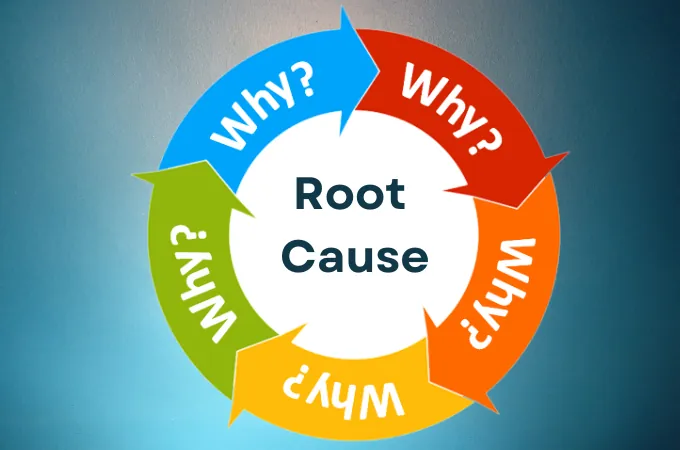Equipment failure doesn’t just happen out of nowhere — it’s a process. The truth is that maintenance issues often happen because of a series of totally avoidable technical problems and process failures (PFMEA). That’s where the 5 whys method comes in handy. It helps figure out the cause-and-effect path of failure as part of a bigger root cause analysis, or RCA.
Origin of the 5 Whys Technique
The 5 Whys method was first created by Sakichi Toyoda and was used within the Toyota Motor Corporation while they were developing their manufacturing methods. It’s a crucial part of problem-solving training, especially in the Toyota Production System. The person behind this system, Taiichi Ohno, said that the 5 whys method helps make the nature of the problem and its solution clear by asking “why” five times.
Even though it started at Toyota, the 5 Whys is now used in other places like Kaizen, lean manufacturing , lean construction, and Six Sigma. Interestingly, it wasn’t originally made for root cause analysis; it was originally developed as a method to better understand why new product features or manufacturing techniques were needed. The Five Whys is also a part of the Six Sigma DMAIC (define, measure, analyze, improve, control) method. This method is like a plan for making company processes better.
When to Use the 5 Whys Method?
Sometimes, organizations can lose their way when faced with tough situations that could become big problems for continued growth and making money.
But here’s where the 5 Whys technique comes in handy. It’s powerful because it can help solve almost any problem, as long as the people involved are close to the situation and give answers that are logical and true. The 5 Whys works well for problems that involve people, like situations with data entry or personal judgment. This might include examples such as manually reordering stock or parts.
How to Use the 5 Whys Root Cause Analysis?
This model follows a simple seven-step 5 Whys process:
-
Build a Team
Get a group of people who know about the specific problem and the process you’re trying to fix. Include a facilitator to keep the team focused on finding effective solutions.
-
Define the Problem
Discuss the issue with your team and create a clear problem statement that everyone agrees on. For instance, “Team A isn’t meeting response time targets.” Write it down, leaving space for answers to the repeated question, “Why?”
-
Ask the First “Why?”
Ask your team why the problem is happening (e.g., “Why isn’t Team A meeting response time targets?”). Look for factual answers, not guesses. Record their responses as brief phrases below the problem statement.
-
Ask “Why?” Four More Times
For each answer from Step 3, ask “why” four more times in a row. Frame each question based on the previous answer.
-
Know When to Stop
Stop when asking “why” doesn’t produce more useful responses. The root cause should become clear. If uncertain, consider using a more in-depth problem-solving technique.
-
Address the Root Cause(s)
Once you identify at least one root cause, discuss and agree on countermeasures to prevent the problem from happening again.
-
Monitor Your Measures
Keep a close eye on how well your countermeasures work in eliminating or minimizing the initial problem. Adjust or replace them as needed. If changes occur, consider repeating the 5 Whys process to confirm the correct root cause.
5 Whys Examples
Here are examples of asking “why” five times to get to the root cause:
- Why did the machine stop? Because there was too much load, and the fuse blew.
- Why was there too much load? Because the bearing didn’t have enough lubrication.
- Why was it not lubricated enough? Because the lubrication pump wasn’t working well.
- Why wasn’t the pump working well? Because the pump’s shaft was worn and making noise.
- Why was the shaft worn out? Because there was no strainer, and metal scraps got in.
Instead of just fixing the fuse or pump, asking “why” five times helps find and fix the real problem. The number five isn’t crucial; it’s about digging until you find the main issue and get rid of it.
Frequently Asked Questions About the 5 Whys Technique
-
What Is the 5 Whys Technique?
The 5 Whys Technique is a way to solve problems by asking “why?” repeatedly. It helps quickly find the main cause of a situation by encouraging critical thinking and logical conclusions.
-
Why Is 5 Whys Analysis Important?
5 Whys analysis is important because problems usually have many layers, and the real cause is often deep beneath the surface. By asking “why?” repeatedly, you’re not just dealing with the symptoms of an issue, but getting to the heart of the problem.
-
Who Invented the 5 Whys Method?
Sakichi Toyoda, a Japanese inventor, industrialist, and visionary behind Toyota Industries came up with the innovative 5 Whys technique in the 1930s to develop a solid problem-solving method.
-
Why Only Five “Whys”?
The 5 Whys technique is built on the idea that asking “why” five times can uncover the root cause of a problem. It’s a method to dig deep and find the real issue and effective solutions instead of just remedying superficial symptoms.
-
What Techniques Help with Five Whys Analysis?
Two common ways to do the 5 Whys analysis are using visualization tools like the Fishbone diagram (also called the Ishikawa diagram) or process mapping. Other useful tools for root cause analysis include process mapping, the Failure Mode and Effects Analysis (FMEA), and the Scatter diagram.






